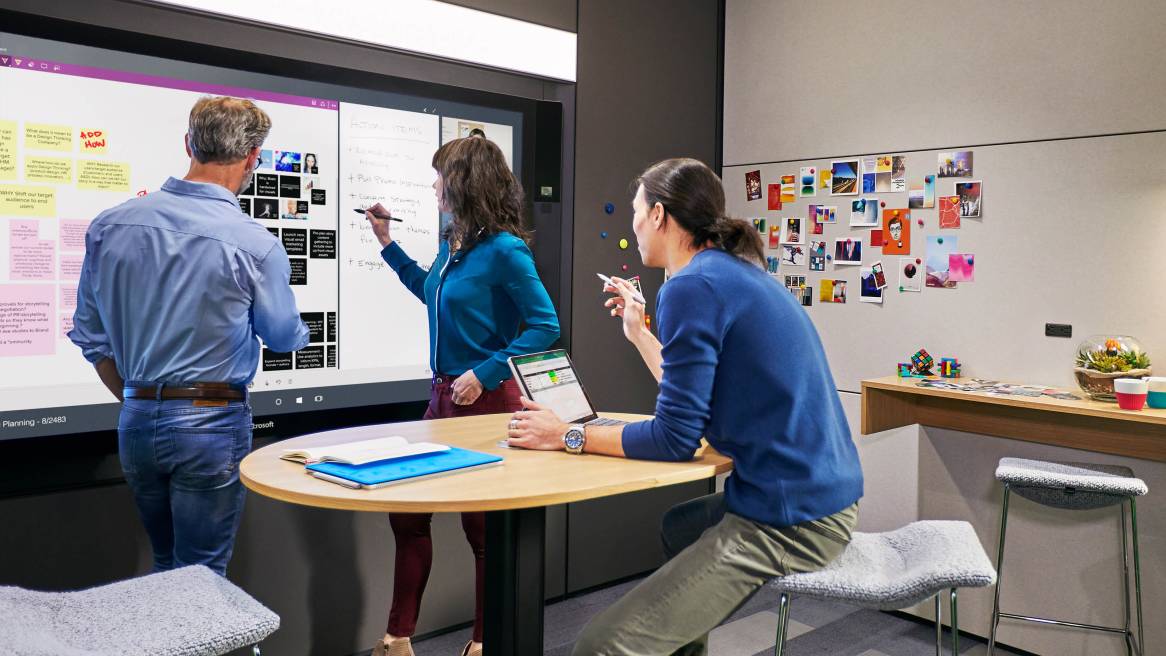Place + Technology Drive Creative Performance
Despite what you may have grown up believing, people are not born creative. People don’t grow up destined for careers as artists or musicians. Research tells us creativity is an iterative process in which anyone can engage, and not restricted to a type of person.
This week, Steelcase and Microsoft announced a new partnership that will help people reach their creative potential at work. Both Steelcase and Microsoft believe we all have the capacity to create. But, joint research* by both companies reveals while people feel more pressure to produce creative work, the conditions for creativity are suboptimal in most workplaces:
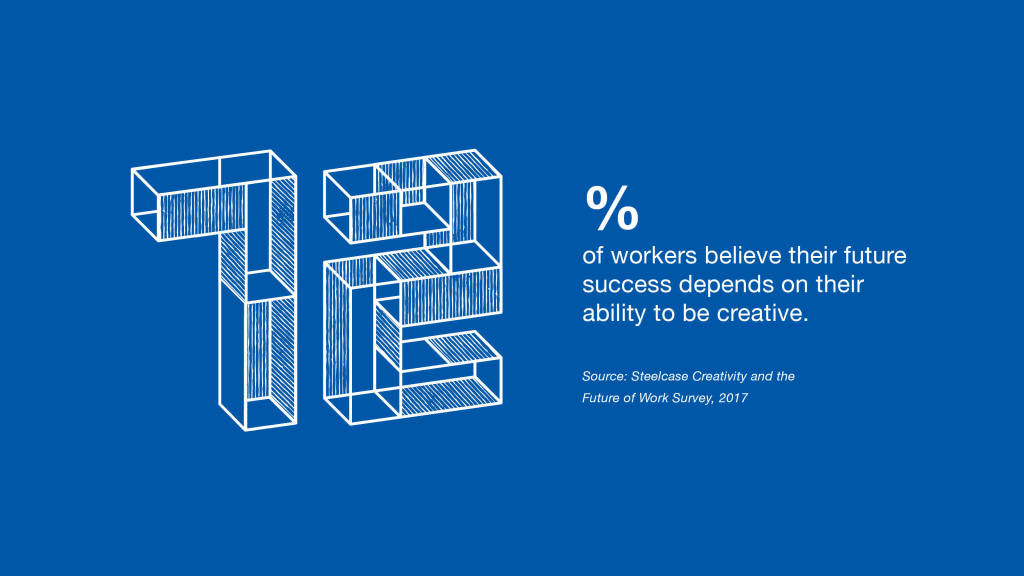
| 83% | People who say they are asked to be creative at work either weekly or daily. |
| 72% | Diverse group of workers who say their future success depends on their ability to be creative. |
| 40% | Less than half of workers say they have a culture that encourages creativity. |
| 44% | People who feel like they could be more creative at work if they had a place to work without distractions. |
| 25% | People who think they can be creative in places available for group work. |
Rhythm of Creativity
Work used to be very linear — a process focused on efficiency with repetitive tasks where people could specialize. But, the need for more creative work requires a much different rhythm. While there are a variety of models for the creative process– as early as 1926, when social psychologist Graham Wallas published “The Art of Thought” — researchers have identified common elements. Creativity is the ebb and flow of activities that involves working alone, in large and small groups or in pairs. The process is fluid and ideas evolve as teams iterate in an organic way.
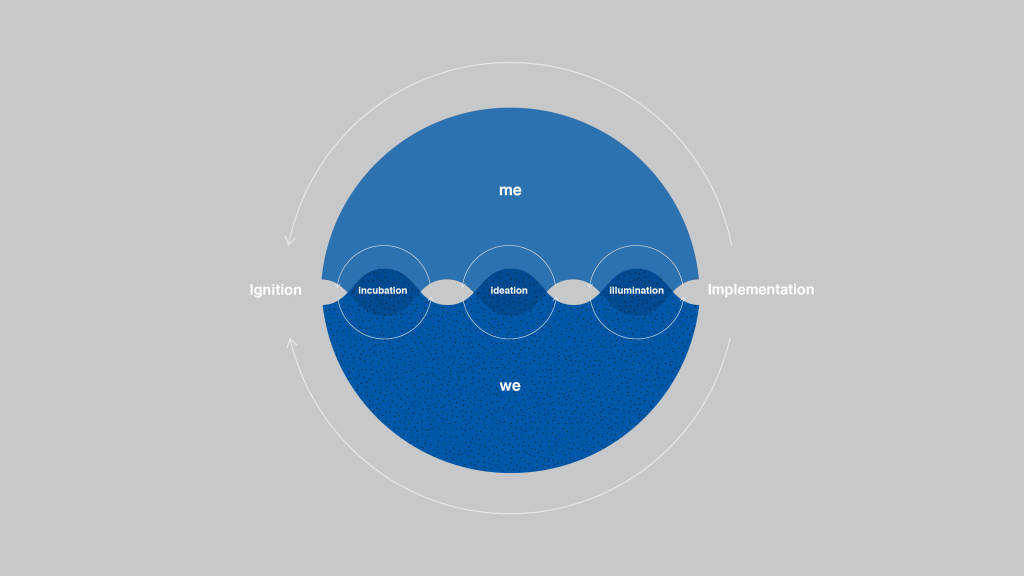
Creativity is an iterative process
Creativity is an iterative process. Work used to be driven by efficiency. The process was intentionally linear and divided into parts in which people could specialize.
But, the problems we face today are so much more complex. They require creative thinking and a very different work process in which people and ideas diverge, converge and iterate.
The Disconnect between Place and Technology
To support this creative process, we need a new set of creative places and technologies. Until now, space and technology in the workplace have often been planned separately by different teams with different objectives. That’s why Steelcase and Microsoft are working together to develop Creative Spaces, an immersive ecosystem that brings together space and technology to help people generate new ideas and move them forward.
This new set of Creative Spaces includes a range places and technologies to enable a creative rhythm. A balanced ecosystem includes technology that is both mobile and integrated into the physical environment as well as spaces designed for individual “me” work and “we” group work.
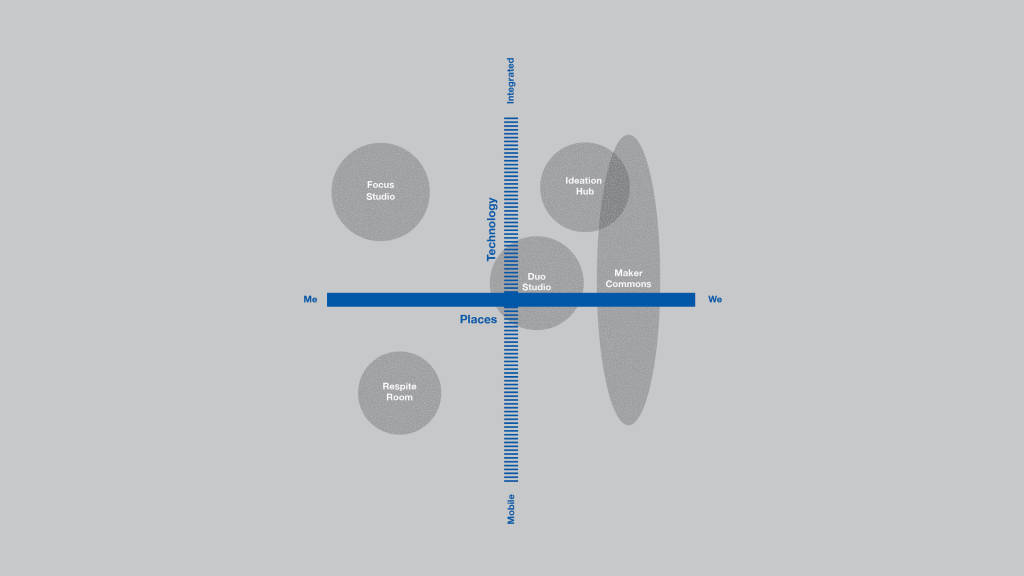
A Diverse Ecosystem
People need an ecosystem of interrelated places and devices to support the different stages and activities of creative work. A diverse ecosystem includes mobile and integrated technology, as well as spaces designed for individual “me” work and “we” group work.
Five initial Creative Spaces are on display at the Steelcase WorkLife Center in New York City.
The Ecosystem of Creative Spaces includes:
The Focus Studio
The Focus Studio is where ideas incubate before sharing them with a group. It supports individual creative work time and the ability to get into flow quickly while also allowing quick shifts to two-person collaboration.

Key Features
Posture: The Gesture® chair supports the range of postures people assume when using the Surface® Studio to create. The AirTouch® table lifts to switch quickly from sitting to standing to encourage movement and boost energy.
Privacy: The space keeps information private and reduces visual distraction. V.I.A.® walls keep ambient noise out so you can stay in flow.
Proximity: The table facilitates brief, shoulder-to-shoulder collaboration, sharing content from Surface® Pro 4 or Surface® Book or to see the big picture on Surface® Studio through wireless projection. Storage with integrated lighting slides open and becomes an extension of the work area.
The Duo Studio
The Duo Studio was created with the knowledge that working in pairs is an essential behavior of creativity. This space helps build trust — two people can co-create shoulder-to-shoulder while also supporting individual work. An informal lounge setting creates a place to relax and re-energize during intense work sessions.
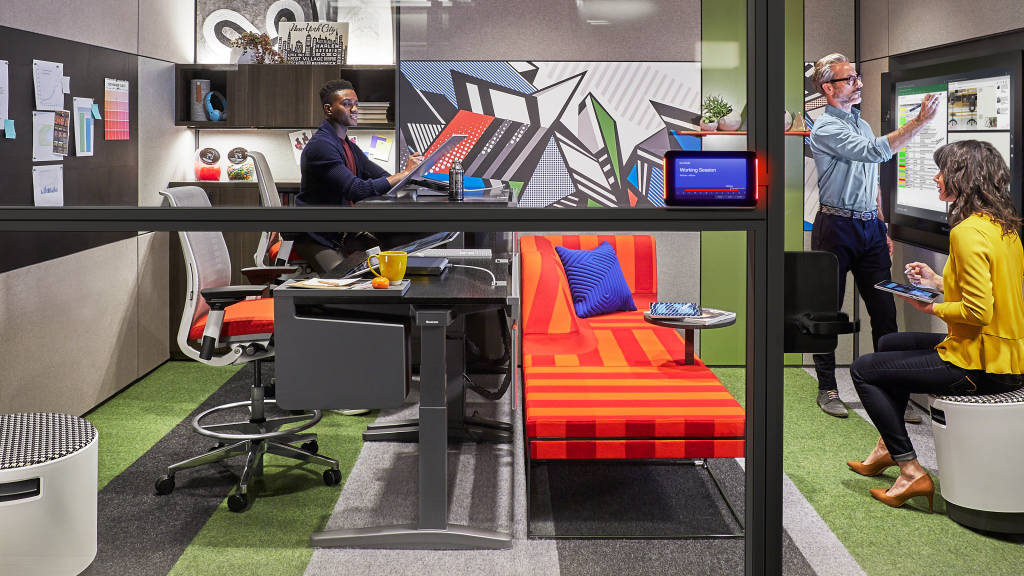
Key Features
Posture: Ology™ height-adjustable desks are side-by-side, making it easy to sit or stand, work individually in parallel or lean over to collaborate, maintaining flow and consistency using Surface® Dial and Surface® Pen. Umami™ lounge creates a place to relax and reenergize during intense work sessions.
Privacy: V.I.A.® walls help mitigate distractions and allow private conversations. The “I’m Done” security feature on Surface Hub™ safely removes all content from the previous session to encourage rapid starts for new collaboration.
Proximity: The configuration is an intimate environment that supports easy access to technology, storage, analog content and your teammates. It offers an informal, theater-like setting for reviewing work at the integrated Surface Hub™.
The Maker Commons
The Maker Commons encourages quick switching between conversation, experimentation and concentration. Here, people can socialize ideas and engage in rapid prototyping — essential parts of creativity. To achieve privacy and focus in open areas, a work lounge with privacy screens creates a cocoon-like environment where people can bring their mobile devices and do focused work.
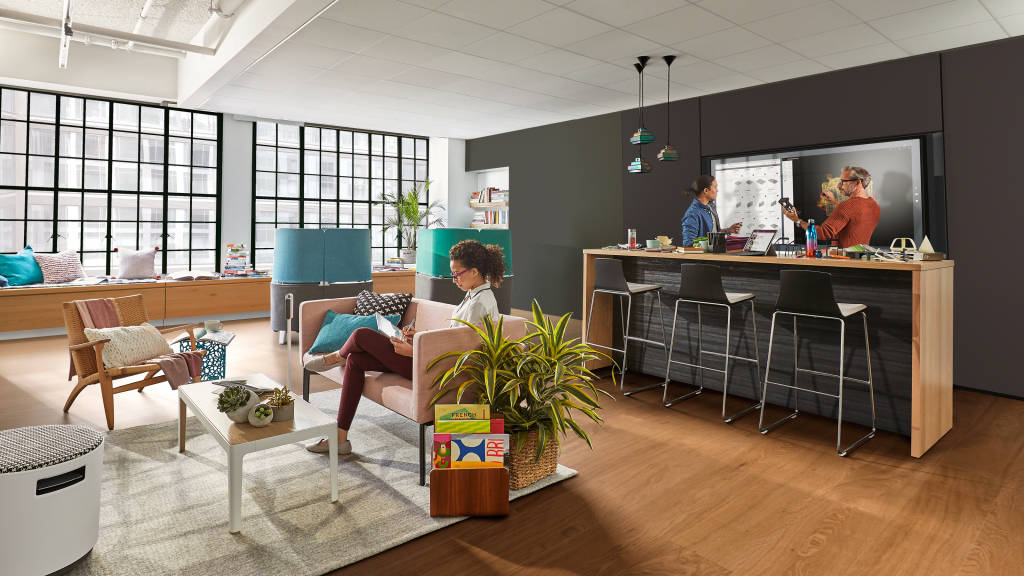
Key Features
Posture: This space supports a full range of posture – seated, standing, lounging, perching — encouraging movement without breaking flow.
Privacy: Brody® Worklounge is a micro-environment for privacy and focus in open areas including integrated lighting, power and bag storage. The Brody screens create a cocoon within the open plan to sketch or take notes on your Surface® Pro 4 between brainstorms.
Proximity: Centrally located in the ecosystem, this space is a communal atmosphere to gather and play with new ideas. It allows people to shift easily from “me” to “we” activities and through the different stages of the creative process.
The Ideation Hub
The Ideation Hub is a great place for brainstorming. It’s a high-tech destination that encourages active participation and an equal opportunity to contribute. Here people can co-create, refine and share ideas with co-located or distributed teammates.
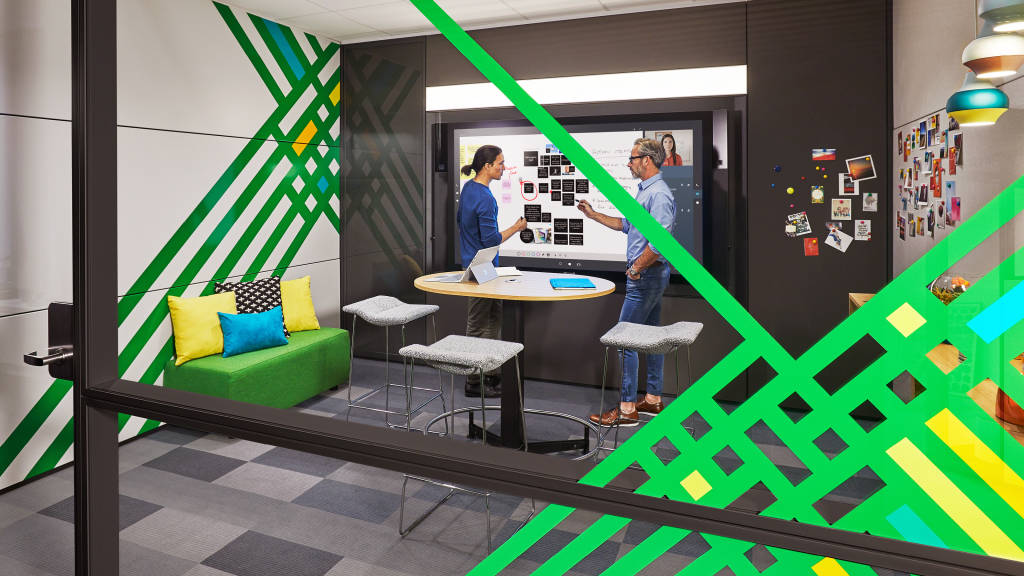
Key Features
Posture: Stool height seating encourages movement and quick shifts from interaction with personal devices to group collaboration at the Surface Hub™.
Privacy: V.I.A.® walls integrate the Surface Hub™ and provide unparalleled acoustic privacy to prevent disruptions and enhance remote user participation.
Proximity: The furniture elements are scaled to allow ample circulation and the ability to engage or step back from the action and reflect or gain a different perspective.
The Respite Room
The Respite Room is designed with the understanding that creativity requires balancing active group work with solitude and individual think time. Here, people may generate their own ideas without interruption or spend time absorbing information they just heard.
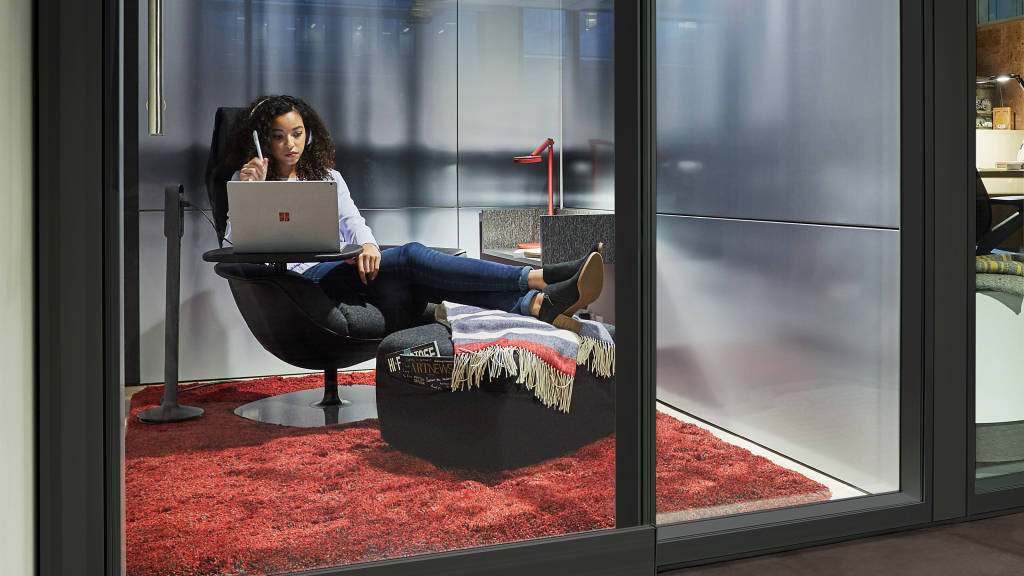
Key Features
Posture: Relaxed postures can support diffused attention, allow the brain to wander and lead to ‘eureka!’ insights. It also supports active brainstorming while away from your personal workstation allowing quick switches between typing and working with digital ink or touch.
Privacy: V.I.A.® walls create acoustic privacy and visual relief reducing external stimuli, allowing the brain to rest, form new connections and generate new ideas. Easily switch brain modes to active work and focus without disruptions.
Proximity: Thread® Modular Power makes it easy to charge devices. Massaud Ottoman opens to provides a place to store personal items. The highly adjustable LED Dash® light allows you to control the light level.
Explore Creative Spaces and the Microsoft and Steelcase partnership.

